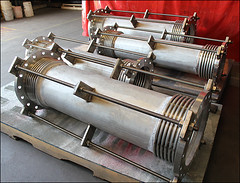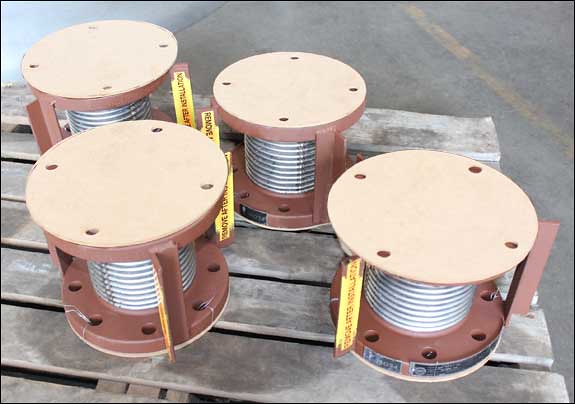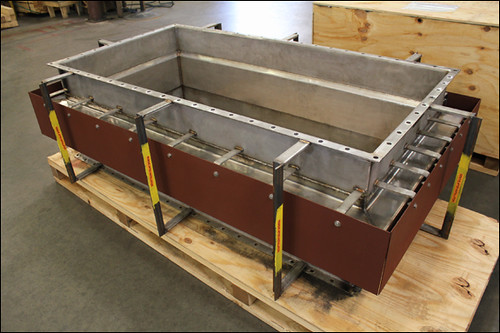
U.S. Bellows designed these single gimbal expansion joints with floating ring gimbal attachment to the pipe for a flare gas and steam application at a methanol plant in Texas. The bellows were fabricated from Inconel® 625 LCF, the liner and the weld-ends from 316H stainless steel, the cover from 304 stainless steel, and the gimbal structure from A516 carbon steel. The expansion joints are 48″ diameter and are 61 3/8″ in overall length, and are designed for an operating temperature of 752°F at 50 psig. All expansion joints were 100% dye penetrant, X-ray, and hydrotested prior to shipment.
Resources
Resources
Custom Designed Stainless Steel Tied Universal Expansion Joints

These tied universal expansion joints were custom designed by U.S. Bellows for a pipeline in Connecticut. All components of the expansion joints were fabricated from 316 stainless steel. The job was comprised of units that were 12″ or 16″ in diameter and 60″ in OAL. They are designed for an operating pressure of 10-125 psig at 450°F and a lateral movement of +/- 1″. All of the expansion joints were 100% dye-penetrant tested and hydro-tested at 150 and 175 psig prior to shipment.
Custon Designed Tied Universal Expansion Joints

These tied universal expansion joints were custom designed by U.S. Bellows for a pipeline in Connecticut. All components of the expansion joints were fabricated from 316 stainless steel. The job was comprised of units that were 12″ or 16″ in diameter and 60″ in OAL. They are designed for an operating pressure of 10-125 psig at 450°F and a lateral movement of +/- 1″. All of the expansion joints were 100% dye-penetrant tested and hydro-tested at 150 and 175 psig prior to shipment.
Custom Designed Stainless Steel Tied Universal Expansion Joints
These tied universal expansion joints were custom designed by U.S. Bellows for a pipeline in Connecticut. All components of the expansion joints were fabricated from 316 stainless steel. The job was comprised of units that were 12″ or 16″ in diameter and 60″ in OAL. They are designed for an operating pressure of 10-125 psig at 450°F and a lateral movement of +/- 1″. All of the expansion joints were 100% dye-penetrant tested and hydro-tested at 150 and 175 psig prior to shipment.
Single Expansion Joints Custom Designed for a Hydrocarbon Vapor Pump
| Type: | Single Expansion Joint |
| Size: | 4″ Diameter |
| Material: | 321 Stainless Steel with 304 liners | 105N CS |
| Design | 212°F Operating Temperature |
| Testing: | 100% Dye Penetrant | Hydro-tested |
U.S. Bellows custom designed 4” diameter single expansion joints for a hydrocarbon vapor pumping application in Saudi Arabia. The bellows are fabricated from 321 stainless steel with 304 liners, and the flanges are 105N carbon steel. The expansion joints are designed for 212°F at 53 psig. They are capable of 1.37″ compression, 0.59″ axial, and 0.39″ lateral movement. A hydro-test and dye-penetration exam were performed on the units prior to shipment.
75″ Long Rectangular Expansion Joint Designed for a Boiler Exhaust Application
U.S. Bellows designed and fabricated this rectangular metallic expansion joint for a boiler exhaust application. The expansion joint is 45½” x 75½”. The unit’s bellows, liner, and angle flanges are 304 stainless steel and the cover is carbon steel. The expansion joint is designed for an operating temperature of 500°F at 15 psig. A 100% dye penetrant examination and air and soap leak test was performed prior to shipment.
Why is necessary to eliminate excessive flexibility?
Excessive flexibility increases material costs, increases pressure drops, increase vibration, and creates 2-phase flow occurrences.
How are failures due to inadequate flexibility now almost nonexistent?
Increase in the number of segments (nodes) reviewed though computer use and use of precise calculations.
10″ Dia. Universal Expansion Joints for HVAC Service in California

U.S. Bellows designed these universal expansion joints with flanges for HVAC services in California. The bellows are fabricated from 304 stainless steel, the flanges from A105 carbon steel, and pipe from 106 Gr. B carbon steel. The expansion joints in this project ranged from 3″ to 10″ in diameter, and are designed for an operating temperature of 160°F to 353°F at 120-125 psig, with an axial compression of 1.5″ and a lateral deflection of 1.3″. All expansion joints were 100% dye-penetrant tested and hydro-tested prior to shipment.
What are individual Stress-Intensification Factors (SIF) applied for?
Welds, fittings, branch connections , and other piping components where the possibility of fatigue failure could occur.
What is the Stress-Intensification Factor?
The Stress-Intensification Factor is the ratio of the maximum stress intensity compared to the nominal stress.
What does the Maximum Shear Stress Theory state?
The maximum shear stress theory states that failure of a piping component occurs when the maximum shear stress exceeds the shear stress at the yield point in a tensile test.
Out of the Six Theories of Failure, which are the 2 that are the most widely used?
The Maximum Principle Stress Theory and Maximum Shear Stress Theory
What does the Maximum Principle Stress Theory state?
This theory states that yielding in a piping component occurs when the magnitude of any of the three mutually perpendicular principal stresses exceeds the yield strength of the material.
What are the 5 modes of failure of piping design?
Failure by general yielding, yielding at sub-elevated temperature, brittle fractures, and fatigue.
What is the purpose of Stress Analysis?
Stress analysis ensures the safety of piping and piping components, safety of connected equipment and supporting structure, and that piping deflections are within limits.
10′ Long Expansion Joints Designed for a Nuclear Energy Facility
| Type: | Single Expansion Joint |
| Size: | 18″Diameter and 120″ OAL |
| Material: | 316 Stainless Steel |
| Design | 35 psig at an Operating Temperature 1200°F |
| Testing: | 100% Dye Penetrant | Hydro-tested |
U.S. Bellows manufactured these single expansion joints for a nuclear energy facility in Ohio. The expansion joints are 18″ in diameter and 120″ in OAL. All components are fabricated from 316 stainless steel. The assemblies are capable of 1.1″ axial movement, 0.5″ lateral movement, and are designed for 35 psig at an operating temperature of 1200°F. One end is beveled for welding and the other end is fitted with a special 316 stainless steel clamp assembly. The expansion joints were dye-penetrant tested and hydro-tested prior to shipment.
What is Stress Analysis?
A term applied to calculations, which address the static and dynamic loading, resulting from the effects of gravity, temperature changes, internal pressures, fluid flow, seismic activity, and any external loads.
What is the Stress-Strain curve?
It is a visual representation of the effects of various loading conditions on a piping system between stress and strain.
What are the 5 majority causes of failures (after flexibility analysis) of a system?
Vibration, thermal bowing, creep, thermal fatigue, and steam/water.



